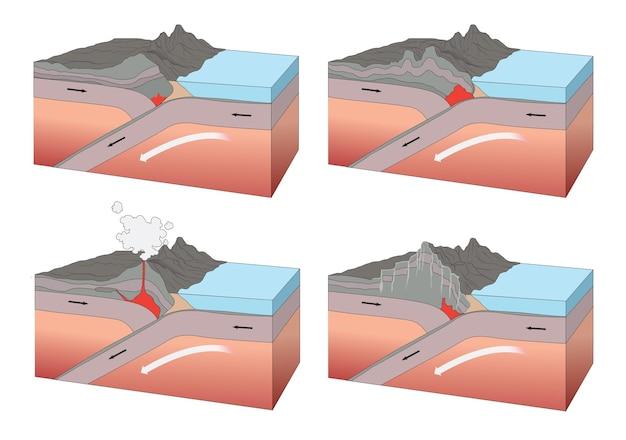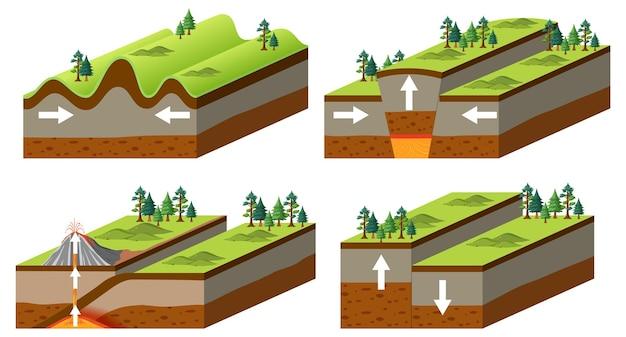What do you think of when you hear the word “movement”? Perhaps images of bustling cities, busy airports, or even migration patterns come to mind. In the fascinating field of geography, movement refers to much more than just physical travel. It encompasses a spectrum of actions and processes that shape the way people, goods, and ideas traverse our vast world.
In this blog post, we will delve into the three types of movement in geography and uncover their significance in understanding the dynamics of spaces and places. Whether you’re a geography enthusiast or simply curious about how our world is interconnected, join us as we explore the intricacies of movement that shape our global landscape.
So, let’s embark on a journey of discovery and unravel the secrets behind the three types of movement in geography. From the movement of people and goods to the flow of information and ideas, we’ll examine each type with examples and illuminate the fundamental role they play in shaping our ever-evolving world. Get ready to uncover the fascinating dynamics that drive our interconnected planet.

Types of Movement in Geography
In the vast field of geography, movement is a crucial concept that helps us understand how people, ideas, and resources travel across the globe. It’s like a well-coordinated dance performance, with all its twists, turns, and graceful movements. But, unlike a dance performance, geography has three main types of movement. Let’s dig deeper into each of them:
1. Human Movement
Oh, humans, always on the go! Whether it’s traveling for leisure or migrating for a better life, humans are constantly in motion. Human movement can take various forms, such as voluntary migration, commuting to work, or simply exploring different parts of the world. Just imagine the number of frequent flyer miles we could rack up if they were transferable!
– Voluntary Migration
People pack their bags and move for various reasons. It could be the pursuit of better economic opportunities, escaping political instability, or even just a desire for a change of scenery. Voluntary migration is like a never-ending game of hopscotch, with people leaping from one place to another, hoping for a better landing.
– Commuting to Work
Ah, the daily grind! Many of us know what it’s like to embark on the arduous journey to and from work each day. From bumper-to-bumper traffic to cramped subway rides, commuting is a form of movement that showcases our collective ability to withstand long hours of stir-crazy confinement. It’s like an episode of Survivor, but without the tropical island and camera crew.
2. Physical Movement
Just as humans move, so does nature. From the minute wiggling of tiny organisms to the grandiose migration of animals, physical movement in geography encompasses the wonders of the natural world. It’s like a wildlife documentary, but without the soothing voice of Sir David Attenborough.
– Animal Migration
Get ready for the Great Animal Migration, the wildest show on Earth! Every year, millions of animals embark on epic journeys across vast distances. Whether it’s the great wildebeest migration in Africa or the tiny turtles shuffling toward the sea, animal migration is a spectacle that leaves us in awe of nature’s ingenious navigation system. It’s nature’s version of the Amazing Race, but with no cash prize at the finish line.
– Plate Tectonics
Beneath our feet, hidden from plain sight, the Earth’s crust is constantly on the move. Tectonic plates, those colossal puzzle pieces, shuffle and collide, giving rise to earthquakes, volcanoes, and majestic mountain ranges. It’s like a game of geological chess, with continents as the players and millennia as the moves. After all, who said Earth isn’t a fan of a good shuffle?
3. Informational Movement
In the digital age, information moves faster than a cheetah chasing its prey. From news articles to viral cat videos, the exchange of information shapes our understanding of the world. It’s like a never-ending stream of consciousness, but with fewer existential crises (hopefully).
– Internet and Global Communication
Thanks to the internet, the world can now fit into the palm of our hands. Information zips across the globe at lightning speed, connecting people from all corners of the Earth. It’s a bit like Hermione Granger’s Time-Turner, allowing us to navigate through space and time with a simple click or tap. The whole world is just a Google search away!
– Cultural Diffusion
Like a subtle whisper in a crowded room, culture spreads and intertwines with incredible ease. From food to fashion, ideas to ideologies, cultural diffusion is an ongoing conversation among human societies. It’s like sharing a secret recipe; once it’s out in the open, everyone wants a taste. So, whether it’s tacos in Tokyo or kimonos in Kansas, cultural exchange adds spice to our lives.
So there you have it, the three types of movement in geography: human movement, physical movement, and informational movement. From humans bravely exploring new lands, to animals on their epic adventures, and the lightning-fast exchange of information in the digital era, movement shapes the world we live in. So, let’s keep dancing to the rhythm of geography’s enchanting movements!

FAQ: What are the Three Types of Movement in Geography?
In the vast realm of geography, movement plays a crucial role in understanding how people, goods, and ideas traverse the globe. Unraveling the mysteries of this multifaceted concept can feel like embarking on an adventurous quest. Fear not, for we have compiled a comprehensive FAQ-style guide to shed light on the three types of movement in geography. So, grab your compass, and let’s dive in!
What Does Thane of Cawdor Mean
Ah, Shakespeare’s Macbeth has certainly left us with some intriguing questions. The Thane of Cawdor, as referred to in the play, was a noble title bestowed upon a character. In real-world context, a Thane was an aristocratic landowner or governor in medieval Scotland.
Why is Thane Called Thane
The title “Thane” derives from the Old English word “þegn,” meaning servant or attendant. In ancient times, Thanes served as loyal companions and military leaders, earning their elevated status through valor and allegiance.
Is a Thane a Lord
Indeed, a Thane could be considered a precursor to the noble titles we associate with lords. However, the exact hierarchy and distinctions varied across different regions and eras. While Thanes held considerable power, the title itself is not synonymous with “lord” in the modern sense.
What is the Difference Between a Thane and an Earl
Ah, here we delve into the intricate web of medieval titles. While both Thanes and Earls were noble figures, there were subtle distinctions between them. Thanes typically governed smaller regions, while Earls oversaw larger territories. Think of it as the Thane being the smaller knight on the chessboard, while the Earl is the more prominent rook.
What Does Movement Mean
Movement, in the context of geography, refers to the transportation of people, goods, and ideas between different locations. It captures the dynamic nature of our world, showcasing how individuals migrate, trade flourishes, and cultures intermingle.
What Does Thong Mean
Hold on to your horses! While the word “thong” may conjure up images of flip-flops or a certain type of undergarment, it has no direct relevance to our geographic discussion. Sometimes words have multiple meanings, and it just so happens that “thong” takes us down a different path altogether.
What Are Some Examples of a Place
Ah, the beauty of places! From bustling cities to serene natural landscapes, the world is brimming with distinctive locations. Some noteworthy examples include the enchanting city of Paris with its iconic Eiffel Tower, the lush Amazon rainforest teeming with biodiversity, and the breathtaking Serengeti National Park in Tanzania, where majestic wildlife roams free.
Is Macbeth a Thane
Ah, the infamous Scottish play! Indeed, Macbeth begins his tragic journey as the Thane of Glamis. However, his encounter with a trio of witches and his insatiable ambition soon propels him into a twisted web of power, leading him down a treacherous path to become the Thane of Cawdor and eventually the King of Scotland.
What Are the 3 Themes of Movement
A symphony of movement unfolds in geography, with three main themes guiding our understanding:
1. People Movement:
From ancient migrations to modern-day commuting, people have always traversed the Earth. Whether driven by a quest for new horizons, economic opportunities, or simply a desire to explore, human movement shapes our societies and cultures.
2. Goods Movement:
The exchange of goods has been a cornerstone of human civilization since time immemorial. From the ancient Silk Road to today’s global trade networks, goods flow across borders, linking economies and enabling the consumption of diverse products.
3. Idea Movement:
Ideas, like wild horses, gallop across continents, challenging norms and sparking innovation. From the spread of philosophical schools in ancient Greece to the digital revolution’s realm of viral content, the movement of ideas shapes our beliefs, knowledge, and cultural evolution.
What Are the Three Types of Movement in Geography
You’ve arrived at the crux of our journey! The three types of movement in geography are:
1. Migration:
This refers to the long-term movement of people from one place to another. Whether in pursuit of economic opportunities, fleeing conflict, or seeking a better quality of life, migration leaves its mark on both the places left behind and the new destinations.
2. Trade:
Trade, the lifeblood of economies, encompasses the movement of goods across different regions. Whether by land, sea, or air, goods journey from production centers to markets, sustaining societies and fostering cultural exchange.
3. Communication and Information Exchange:
In an interconnected world brimming with digital wonders, communication and information exchange have become synonymous with movement. Through technological advancements, ideas, news, and knowledge travel at lightning speed, transcending physical boundaries and connecting us like never before.
So there you have it, fellow travelers of knowledge! Armed with an understanding of the three types of movement in geography, you can now navigate the terrain of this captivating discipline with confidence and curiosity.
Safe travels, intrepid explorers of the world! 🌍
